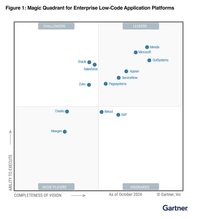HELLO THERE LOW-CODER!
We’re excited to introduce you to the dynamic world of low-code platforms. Whether you're a developer, an IT professional, or a business user looking for smarter digital solutions, this site is designed to help you find the platform that best suits your needs.
Here, you'll find a clear and up-to-date overview of the most widely used low-code platforms on the market. Each platform offers its own strengths and unique features, which we've highlighted to help you quickly understand what sets them apart. Rather than focusing on limitations, we shine a light on what each platform does best—because there’s no such thing as a one-size-fits-all solution.
To make things even easier, we’ve included a short introductory video for each platform. These videos provide a quick look at core features, practical capabilities, and a few interesting facts and figures.
We’ve also evaluated each platform across several key areas and provided a final recommendation based on our findings. After that, you’ll find a step-by-step guide to help you choose the right low-code tool based on your specific business needs.
Finally, we take a look ahead and share our insights on where the low-code market is headed in 2025, 2026, and 2027.
An Enterprise Low-Code Application Platform (LCAP) speeds up custom app development by reducing coding requirements. It includes low-code tools for UI design, business logic, workflow, data services, testing, deployment, and management.
Optional features can include catalog management, custom API generation, advanced UI, process automation, event-driven architecture, AI-powered development, team collaboration, citizen developer support, multi-cloud compatibility, and enterprise-grade performance and security. LCAPs are used by enterprise developers and fusion teams for complex automation, AI-driven insights, and scalable app deployment.
GARTNER® MAGIC QUADRANT.
The Gartner Magic Quadrant is a research methodology by Gartner, Inc. It evaluates technology markets, comparing vendors based on vision and execution. The Quadrant has four quadrants: Leaders, Challengers, Visionaries, and Niche Players. Vendors are placed based on Gartner's assessment.
Leaders
Enterprise LCAP Leaders combine exceptional execution with forward-thinking product strategies, offering robust solutions for organizations worldwide. This year’s Leaders include Mendix, OutSystems, Microsoft, Salesforce, ServiceNow, and Appian, who have solidified their positions through significant growth, customer success initiatives, and global expansion.
Challengers
Challenger vendors demonstrate strong execution but lack the visionary approach of the Leaders, particularly in market strategy and product offerings. These vendors are excelling in their core areas and growing their customer base, but haven't yet broadened their reach to diverse buyer needs. This year, HCL Software, Zoho, and Retool join Oracle in the Challengers quadrant, increasing solution diversity and presenting strong competition to the Leaders.
Visionaries
Enterprise LCAP Visionaries, like Pegasystems, Globant (via GeneXus), and Creatio, offer a compelling strategic vision but may face challenges in execution. Smaller, niche vendors with focused use-case solutions can also be valuable, particularly if execution history isn't a primary concern.
Niche Players
Enterprise LCAP Niche Players are specialized vendors with a regional or vertical focus. While they may not excel in every area, being recognized in the Magic Quadrant is a notable achievement. Huawei, Kintone, Newgen, and Unqork are examples of Niche Players who excel in specific areas like business process automation, content services, or citizen development, making them ideal for particular use cases.
Source: justlowcode.com© & Gartner® 2025
